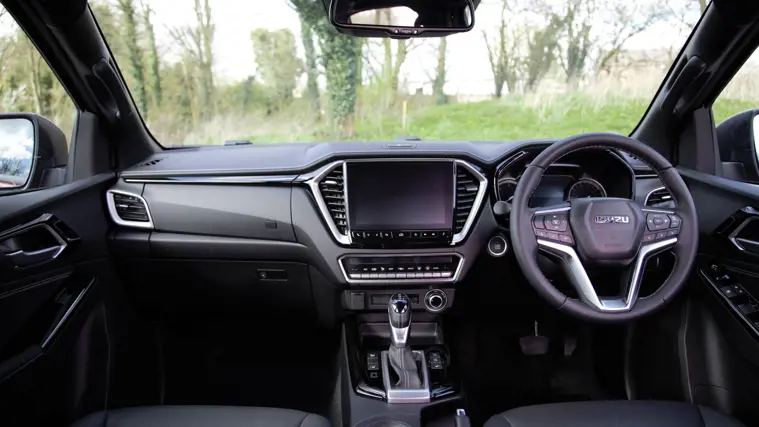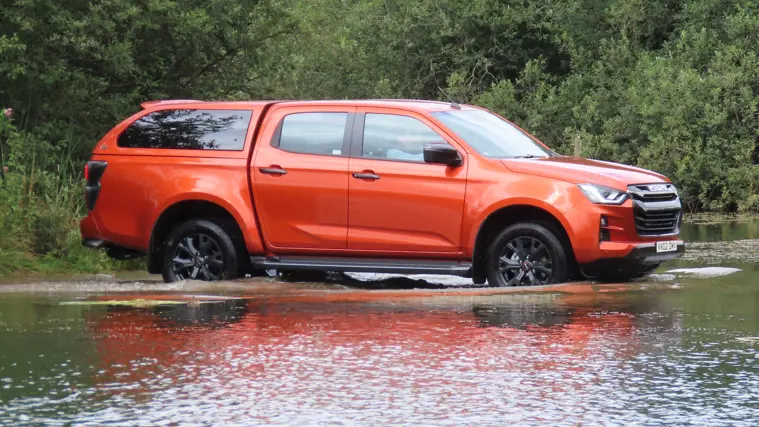Isuzu D-Max Review
The rugged Isuzu D-Max is tough, but lacks the comfort of rivals
Strengths & weaknesses
- Cheap price of basic models
- Good value specifications
- Wide range of bed and cab styles
- Noisy engine
- Frustrating dashboard screen
- Cheap plastics
Many will recognise the Isuzu badge from the numerous commercial vehicles, trucks and HGVs that it adorns but dealers will also happily sit down with private buyers... so long as they are in the market for a pick-up.
That's right, the only 'car' Isuzu sells in this country is the hardy D-Max. A 2017 makeover and recent line-up overhaul has introduced greater choice and higher levels of specification, meaning it could be worth adding to your test drive shortlist should you wish to replace the family wheels with something decidedly more utilitarian.
The extensive range covers everything from single-cab, two-wheel drive workhorses, which boast an enormous rear bed and a hose-clean interior, to more premium all-wheel-drive double-cab variants with leather seats and touch screen infotainment systems.
To make life simple, Isuzu only offers one engine across its entire range. It's down on capacity from the larger (and dirtier) 2.5-litre diesel, to a new 1.9-litre unit, which is slightly lacking on torque but drives down emissions and improves fuel economy.
It's not the quietest or smoothest engine on the market and compared to units found in the rival Mercedes-Benz X-Class, the ever popular Nissan Navara and the Ford Ranger, it comes across as a little agricultural at times. But it is capable of towing up to 3,500kg, and carrying between 1,091 - 1,196kg in the rear bed, so that can be forgiven.
The driving experience follows a similar path, with the aforesaid rivals offering advanced suspension systems, cleverly calibrated steering and plenty of sound-proofing to make the ride and drive as relaxing and 'car-like' as possible. It's not really the case with the D-Max.
Unfortunately, the six-speed manual gearbox can be vague and cumbersome to use (the automatic gearbox is much better) and the ride becomes fidgety and restless when the road surface becomes poor - especially if the rear bed isn't loaded with ballast to keep it jumping around.
That said, this updated Isuzu D-Max is a vast improvement over previous generations and the more expensive Blade variants are very well specified for daily use, with a large double cab offering plenty of space in the back, heated front seats and leather upholstery, a nine-inch touchscreen entertainment system and an abundance of stylish exterior touches.
But in reality, the Isuzu D-Max only really represents good value when specified in the most basic trim levels, which is best avoided by anyone looking to use it as a comfortable daily drive.
In comparison, the top spec Nissan Navara Tekna is slightly cheaper than the D-Max Blade and it feels like a more accomplished proposition, while the most basic Volkswagen Amarok is only slightly more expensive and it comes fitted with a brilliantly smooth 3.0-litre V6 diesel.
For those looking for something slightly more specialist, the D-Max is also offered in an AT35 trim, which packs enormous off-road tyres and other 'Arctic Expedition' features, while specialist models like the Max Huntsman offer solutions to working folk with specific requirements.
Key facts
| Warranty | 5 years / 125,000 miles |
|---|---|
| Bed size | Up to 3.45m2 |
| Width | Up to 1860mm |
| Length | Up to 5315mm |
| Height | Up to 1795mm |
| Tax | £250 per year |
Understanding Isuzu D-Max names
Engine 1.9TD
The D-Max only has one engine, a 1.9-litre engine that is turbocharged (T) and diesel (D).
Gearbox Manual
There is a six-speed manual, or a six-speed automatic on offer with the D-Max.
Trim Blade
There are six trim levels to choose from.
Body type Double Cab
Double cab means four doors, single cab means two doors. The D-Max is available with either.
Isuzu D-Max Engines
1.9 diesel
Many modern pick-up truck manufacturers entice a broad selection of customers with a range of engines, typically reserving the highest outputs for those models most likely to complement a lifestyle of boat-towing, jet ski hauling and motorcycle transportation, while less lavish powerplants are paired to those that will genuinely be used on building sites, farms and other places of work.
The Isuzu D-Max, on the other hand, is only offered with one engine. The engine in question is also smaller than its predecessor. Isuzu claims that new gearing ensures the latest model can still tow 3.5-tonnes of unbraked load and carry up to almost two-tonnes in the rear bed.
That's an impressive load-lugging ability when compared to the previously mentioned and more lifestyle-orientated rivals, but there are plenty of compromises as a result.
The 1.9-litre diesel engine is noisy under harsh acceleration and can feel quite clunky when paired with the manual gearbox. The six-speed automatic does improve things but the overall driving experience isn't the most relaxing on the market today.
However, fuel economy is generally good and the claimed 40mpg in the largest Blade model with a manual gearbox is a cut above the 32.5mpg offered by the lowest powered 3.0-litre V6 diesel in manual Volkswagen Amaroks.
|
Fuel |
Official fuel econmy |
Power |
Acceleration (0-62mph) |
Top speed |
|
|
1.9-litre diesel 4x2 single cab |
Diesel |
45.6mpg |
164hp |
12.7sec |
112mph |
|
1.9-litre diesel 4x4 double cab manual |
Diesel |
40.4mpg |
164hp |
12.7sec |
112mph |
|
1.9-litre diesel 4x4 double cab auto |
Diesel |
36.2mpg |
164hp |
13sec |
112mph |
Isuzu D-Max Trims
Utility, Eiger, Yukon, Utah, Blade, Arctic Trucks AT35
The trim range offered by Isuzu could be viewed as a sliding scale based upon the type of life each model is likely to lead.
Utility models, for example, ditch any luxuries in favour of a hard-working, hard-wearing interior and an array of cab and bed sizes to suit any job.
These models come with LED daytime running lights, 15 or 16-inch steel wheels (with a full-size spare), cloth upholstery, vinyl floor covering, manual air conditioning and electric windows.
Utility really is a basic offering but Bluetooth connectivity and USB points for charging mobile devices are nice touches, while built-in safety systems, such as hill start assist and hill descent control, come into their own when tackling the rougher terrain.
It should come as no surprise that this trim level is also offered in 4x2, 4x4, single cab, extended cab and double cab variants to suit all manner of different use cases.
Eiger remains a hardy truck but throws in some additional specification that will make any impromptu longer journeys more comfortable. These include interior carpets, a CD and six-speaker sound system and a reversing camera.
This trim also begins to look a little more luxurious from the outside, with 16-inch alloy wheels thrown in to the mix, body-coloured bumpers, chrome door handles and a selection of exterior colours that goes beyond the four hues offered in Utility trim.
Yukon starts to feel like a more premium rival throughout, with cruise control, a leather steering wheel and a seven-inch touchscreen entertainment system added.
Outside, the model benefits from stylish 18-inch alloy wheels, silver side steps and front and rear fog lights.
Utah can be seen as the trim level that blends the greatest amount of comfort features, while retaining the big Isuzu's hard-working demeanour.
So, leather upholstery is added, as is DAB radio, Apply CarPlay and Android Auto, rear parking sensors and heated front seats but it still offers the side step-plates and rear bed liner that indicate it's up for transporting an awkward load.
Blade models are by far the most luxurious trucks and feature neat (but largely useless) premium touches, such as illuminated 'puddle lamps' that project the word 'Blade' onto the road surface when parked.
Inside, there are branded mats, leather seats, keyless entry and push button start/stop system, automatic air conditioning and heated front seats.
It's a cool proposition, with contrast stitching making the interior come to life, while the nine-inch multifunction colour touchscreen is the most technically accomplished in the range. However, the touchscreen lags behind rivals in terms of capability and can be very frustrating to use, with menu systems prove to be slow and fiddly to navigate. The DAB radio functionality offers a patchy reception at best.
Blade models can only be specified in Pearl White or Cosmic Black Mica paints but customers are offered the choice of either a colour coded Aeroklas canopy for the rear bed or a black roller cover with rear sports bar to ensure the rear bed isn't left exposed to the elements.
The rear tailgate also boasts a damper function, which means it won't suddenly drop when opened, which makes loading a little easier and safer.
Finally, the Arctic Trucks AT35 model is geared towards serious off-road enthusiasts, so comes with Fox performance series suspension, 35-inch Nokian Rotiiva tyres and a bespoke body kit that flares the wheel arches and generally offers a more aggressive presence.
Isuzu D-Max Reliability and warranty
As Isuzu only has one model for sale in the UK (this one), it doesn’t sell enough cars to be featured in the Auto Express Driver Power survey.
It does however, come with a five year, 125,000 mile warranty. Which is more than the Nissan Navara and Mitsubishi L200, both of which are capped at 100,000 miles. Service intervals are every 12,000 miles or 24 months.
The D-Max doesn't use AdBlue either, which means there's one less thing to worry about.
Used Isuzu D-Max
Despite it not being two years old yet, plenty have found their way onto the second-hand market.
New base-spec Utility models start from £20,409, but pre-registered models start from just £17,795.
Two-year old Yukon models with around 15,000 miles on them start from £16,500, and quite-posh Blade specification trucks can be had from as little as £23,000, as long as you don’t mind them having around 20,000 miles on them.







